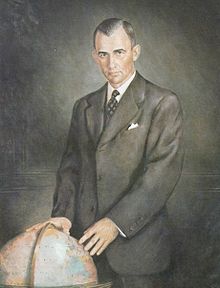| Frank Pace | |
|---|---|
 | |
| 3rd United States Secretary of the Army | |
| In office April 12, 1950 – January 20, 1953 | |
| President | Harry S. Truman |
| Preceded by | Gordon Gray |
| Succeeded by | Robert T. Stevens |
| 8th Director of the Bureau of the Budget | |
| In office February 1, 1949 – April 12, 1950 | |
| President | Harry S. Truman |
| Preceded by | James E. Webb |
| Succeeded by | Fred Lawton |
| Personal details | |
| Born | (1912-07-05)July 5, 1912 Little Rock, Arkansas, U.S. |
| Died | January 8, 1988(1988-01-08) (aged 75) Greenwich, Connecticut, U.S. |
| Political party | Democratic |
| Spouse | Margaret Morris Janney |
| Children | 3 |
| Education | Princeton University (BA) Harvard University (LLB) |
| Signature | |
| Military service | |
| Branch/service | United States Army Air Forces |
| Years of service | 1942–1945 |
| Rank | Major |
Frank Pace Jr. (July 5, 1912 – January 8, 1988) was the 3rd United States Secretary of the Army and a business executive.
Biography

Pace was born in Little Rock, Arkansas, and attended The Hill School, Pottstown, Pennsylvania. In 1933 he graduated from Princeton University, and in 1936 from Harvard Law School.
Pace entered public service in 1936 as an assistant district attorney in Arkansas. He moved onto the Arkansas Revenue Department in 1938. In 1942 he was commissioned into the United States Army Air Forces as a second lieutenant where he served until 1945 in the Air Transport Command, Army Air Corps, reaching the rank of Major.
After leaving the Army in 1945 he returned to public service as an assistant to the United States Attorney General, then later as executive assistant to the Postmaster General. He then moved in 1948 to the Bureau of the Budget, first as assistant director and then as director.
On April 12, 1950, he was appointed Secretary of the Army, where he served until January 20, 1953. In August 1950, to avert a threatened strike during the Korean War, President Truman ordered Pace to seize control of the nation's railroads.
He went on to serve as chief executive officer of General Dynamics Corporation from 1953 until 1962. He was selected as the administrator-designate of the Emergency Transport Agency; part of a secret group created by President Eisenhower in 1958 that would serve in the event of a national emergency that became known as the Eisenhower Ten.
In 1964, Pace joined David Rockefeller to launch the International Executive Service Corps, which was established to help bring about prosperity and stability in developing nations through the growth of private enterprise. Pace went on to serve as president of the IESC.
Pace was the first chairman of the Corporation for Public Broadcasting, from 1968 until 1972.
Pace appeared on the cover of Time magazine on January 20, 1958.
Pace worked for the International Executive Service Corps. In the early 1970s he worked for the first Executive Service Corps (ESC) as a Management Support Organization (MSO) in New York.
Pace died from a heart attack in Greenwich, Connecticut on January 8, 1988, at the age of 75.
See also
References
- "Frank Pace Jr., Former Secretary Of the Army and Executive, Dies". New York Times. January 10, 1988. Retrieved 2009-02-22.
- "Executive Order 10155". Truman Library. 25 August 1950. Retrieved 23 August 2020.
- Simon, Leonard S.; Pace, Frank (August 1971). "Corporate Viewpoints: Interviews with Top Managers: Interview with: Frank Pace, Jr". Interfaces. 1 (6): 18–24. doi:10.1287/inte.1.6.18. JSTOR 25058828.
External links
- A film clip "Longines Chronoscope with Frank C. Pace, Jr (July 18, 1952)" is available for viewing at the Internet Archive
| Political offices | ||
|---|---|---|
| Preceded byJames E. Webb | Director of the Bureau of the Budget 1949–1950 |
Succeeded byFred Lawton |
| Preceded byGordon Gray | United States Secretary of the Army 1950–1953 |
Succeeded byRobert T. Stevens |
| Directors of the United States Office of Management and Budget | ||
|---|---|---|
|  | |
- 1912 births
- 1988 deaths
- 20th-century American lawyers
- United States Army Air Forces personnel of World War II
- Arkansas lawyers
- Businesspeople from Greenwich, Connecticut
- Directors of the Office of Management and Budget
- Harvard Law School alumni
- Businesspeople from Little Rock, Arkansas
- Military personnel from Little Rock, Arkansas
- Princeton University alumni
- The Hill School alumni
- Truman administration personnel
- United States Army Air Forces officers
- United States Secretaries of the Army

